FM CW cable guided intrusion detection radar
a technology of intrusion detection and cable guided radar, which is applied in the direction of waveguides, waveguide type devices, instruments, etc., can solve the problems of increasing the cost of cables, affecting the performance of systems, and relatively low duty cycles
- Summary
- Abstract
- Description
- Claims
- Application Information
AI Technical Summary
Problems solved by technology
Method used
Image
Examples
Embodiment Construction
In the present invention, a FM CW cable guided radar system serves to detect and locate intruders that move in proximity to a cable installed around the perimeter of a site. The cable can go around corners and follow the contours of the site terrain. The cable can be buried to create a covert sensor or used laying on the surface of the ground to facilitate rapid deployment for the detection of intruders. The location information derived from the FFT can be used to point and focus a CCTV camera on the unsuspecting intruder to assess the nature of the intruder.
As shown in the embodiment of FIG. 1, Processor 1 has four ports that connect to two cable sensors. The first 10 meters of the cable, 2A and 2B, are used to connect the processor to the detection portion of the cable such that the processor can be positioned outside of the detection zone. The lead-in cable is the same Siamese leaky cable as used for detection but the processing is designed to eliminate the detection of people or...
PUM
 Login to View More
Login to View More Abstract
Description
Claims
Application Information
 Login to View More
Login to View More - R&D
- Intellectual Property
- Life Sciences
- Materials
- Tech Scout
- Unparalleled Data Quality
- Higher Quality Content
- 60% Fewer Hallucinations
Browse by: Latest US Patents, China's latest patents, Technical Efficacy Thesaurus, Application Domain, Technology Topic, Popular Technical Reports.
© 2025 PatSnap. All rights reserved.Legal|Privacy policy|Modern Slavery Act Transparency Statement|Sitemap|About US| Contact US: help@patsnap.com



